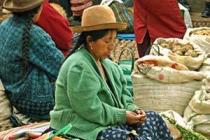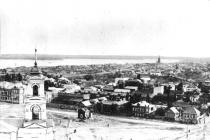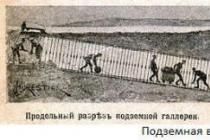Who, if not mothers, know that our children love to remember at 21-22 pm that tomorrow they need to bring an article made of natural materials, a bouquet of dried leaves and flowers, a herbarium, and so on. And what to do? We get together and with a flashlight we go to collect "supplies", and then all night we sculpt, glue, paint, most often without a child. And sometimes they give a task in the garden, it seems it's still light, but it's raining outside. How to collect the required material? In order to at least partially protect myself from this (it will not work completely, unfortunately), I began to collect a "collection" of natural materials, having allocated for this a small shoe box and various smaller boxes and boxes, which I put in this very box from under shoes. Well, plus various books help. So what can we prepare?
1. We dry various leaves. On the way home, pick up a few leaves of different trees. The colors can also be different, which ones come across: yellow, green, red ... The main thing is to select the most beautiful ones, and not try to gain more. After all, we still have many fine days ahead and we will have time to collect a fairly large number of leaves. But let it be the most beautiful.
At home, we revise the "loot" once again, if there are spoiled ones (they didn’t accidentally finish watching them) or you simply don’t like them, we feel free to send them to the trash can. We wash the rest under running water, lay it out on a surface covered with paper or cloth (I cover it with disposable rags from a roll), let it dry with moisture and then into a book, and the book can be put back on the shelf. And you can spread it between sheets of plain paper to press down with something heavy. And let them dry themselves, then they will come in handy.
By the way, if you need to dry the leaves very urgently, then put them between two sheets of white paper and iron them several times with a hot iron.
2. "Airplanes" or "turntables" from maple. On the way home, after the maple seeds are ripe, we cut off several brushes with the child. At home, carefully remove them from the branches, leaving them in pairs, sort out, remove the spoiled ones. Then we rinse and dry for several days on any surface covered with paper: on the table, on the windowsill, on the floor. Once dry, we pour it into a box and send it to a large box or to a cabinet with materials for crafts.
3. Chestnuts and acorns. Perhaps the most popular material for crafts. And they are not always on the trees growing near the house. Therefore, it is better to stock up on them in advance, you don't need much, but a dozen or two will not hurt. By the way, I sometimes find acorns without caps and separately - caps. I also collect this, sometimes you need hats, then acorns, and sometimes whole acorns with hats.
After collecting the acorns and chestnuts, I rinse them well under running water, then dry them for several days in a cool, well-ventilated area (I usually have a small shed). After the fruits have dried, I put them in a box, always shifting them with crumpled paper (you can store them in bulk, but with paper they dry out less and "shrink"). Then I put them in a box with the rest of the natural materials.
4. Cones. The principle is the same as with acorns: I collect, wash, dry. Except for some nuances. More often I collect still closed cones, it is easier to wash them. And they open up later, during the drying process, from the heat. Then I remove a part in this form, whiten a part. Perfect whites do not work out, of course, but they brighten. I do not bleach in bleach, in any case! (For some reason, there is a lot of information on the Internet about bleaching in bleach, I tried it, the “petals” of the cones changed their structure, became soft). How I bleach: wash well, dry. Then I put it in the "mole" or similar means for a while. I take out, rinse and dry until the cones open (they close from moisture), rinse again and dry again. Then I put it in a special solution for bleaching wood (I buy it in hardware stores), periodically drying it if the cone is closed. After a few days I take out, rinse, dry, rinse and dry again. That's all. They say that solutions containing xylot are still good for bleaching. But I haven’t tried it, so I cannot say.
5. Various twigs and sticks... Absolutely "different-sized": both in length and in thickness, even and not very. They are also necessarily present in my box with natural materials. Well washed and dried.
6. If it is possible to get it, then be sure to put a bag with hay or straw... May come in handy too.
What else is in the box: rose hips, dried flowers, reeds, some dried flowers, pumpkin seeds, nuts, sunflower seeds. And certainly - interesting pebbles, including flat pebbles. It's so fun to color. And you can add whatever you find interesting to the box, the larger the stock, the easier it is to make crafts!
Unfortunately, I cannot show my box yet, last year's stocks are over, and this year they have just begun to collect stocks.
In our country, chestnuts are not as popular as in Western Europe, Japan or East Asia, but it is high time to correct this omission. Healing and nutritious nuts grow in the subtropical zone, therefore they are not included in the menu of our traditional cuisine. But after all, avocados and "New Year's fruit" - tangerines, and many other products that often appear on our table are also imported from southern latitudes.
We think, having learned how chestnuts are useful, our housewives will definitely start cooking them for their families. Moreover, the fruits do not require special culinary skills and are delicious simply fried or baked.
We do not grow nutritious nuts and can only be purchased in supermarkets.
Nutritional value of chestnuts
Despite the external resemblance to hazelnuts, the product bears little resemblance to its composition. Chestnuts contain:
- about 60% starch
- 15% sugar
- 6% protein
- 2% fat
The percentage may vary depending on the variety of fruit. Nevertheless, in their effect on the human body, chestnuts are more reminiscent of rice and potatoes than nuts, which are high in protein and fat.
This carbohydrate-rich product is recommended for athletes and people in need of enhanced nutrition to restore energy. After hearty chestnuts, you don't feel like eating for a long time, so they are often included in weight loss diets, with one caveat: in small quantities.
The product is also appreciated by vegetarians as an additional source of vegetable protein.
Chestnuts also contain:
- cellulose
- tannins
- vitamins A, C, K and group B
- trace elements: potassium, calcium, magnesium, phosphorus, sodium, silicon, selenium, copper, zinc
- folic acid
- pectins
- glycosides
The fact that chestnuts are an important ingredient in Mediterranean cuisine, recognized as one of the healthiest in the world, says a lot. With the regular use of fruits, the metabolism improves, the intestines begin to function more actively, toxins are removed more quickly and the enzymes necessary for digestion are produced.
Immunity is strengthened, malfunctions are eliminated of cardio-vascular system, the composition of the blood is normalized and the general tone of the body rises. Italians, French and other southern Europeans love chestnuts for a reason, because they can protect us from stress and improve our mood during the seasonal fall depression. Despite the high content of carbohydrates and sugars, fruits can and should be eaten by people who are struggling with overweight, since in this case fat deposits are not formed and the load on the liver is reduced.
Historical reference
The first seedlings of the sowing (or noble) chestnut were brought from the Asian campaigns by Alexander the Great. He noticed that by eating the fruits of this tree, the warriors become more cheerful and suffer less from stomach problems caused by unusual food.
Magic nuts of youth and beauty
Chestnuts can turn back the clock and bring back the charm of youth. They promote the production of elastin and collagen, proteins involved in cell and tissue renewal.
The trace elements that make up healing nuts have a beneficial effect on the skin, hair and nails, improving their condition and appearance. And zinc and phosphorus also strengthen teeth and gums. 
A cure for many diseases
In the pharmaceutical industry, the familiar horse chestnuts are more often used, decorating the streets in spring with fragrant "candles" of inflorescences, and in the fall throwing fruits in a prickly shell, which are so well suited for handicrafts.
However, Castánea satíva nuts also have healing properties... They are shown when:
- dysentery;
- hemorrhoids;
- cystitis;
- painful menstruation and menopause;
- mastopathy;
- edema of various origins;
- circulatory disorders and thrombosis, since they thin the blood;
- vascular spasms;
- atherosclerosis;
- neuralgia;
- respiratory diseases;
- rheumatism.
Outwardly crushed edible chestnut pulp can be used as a hemostatic, wound healing and disinfectant. Fruits also effectively help with burns, accelerating the process of tissue regeneration.
Calorie content
As you can see from this table, boiled or baked fruits will bring the greatest benefit, but fried and pickled fruits should be eaten a little (no more than 40 g at a time).
If you follow a diet, it is better to eat chestnuts in the first half of the day, then the energy with which they charge the body will have time to be completely used up. But for dinner you can only allow yourself 2-3 nuts.
Who shouldn't eat chestnuts
A carbohydrate-rich product, for all its usefulness, is a heavy food. Therefore, it is undesirable to give it to children before the age of five or six. The fragile body of babies is unlikely to be able to fully digest chestnuts, which threatens an upset stomach, flatulence and colic.
Enter healthy nuts in the children's diet is better boiled, making a puree soup. If the product has caused discomfort in the child, it is advisable to postpone the "acquaintance" with it for some more time and consult a doctor.
Breastfeeding mothers will also have to give up chestnuts so as not to cause excessive gas production or an allergic reaction in the baby. 
Fruits are contraindicated in the following diseases:
- diabetes mellitus
- kidney and bladder stones
- hypotension
- hepatic and renal failure
- inflammatory processes of the gastrointestinal tract
Attention!
Healthy people need to eat chestnuts, but in moderation, so as not to gain excess weight and not to provoke the pancreas.
Raw nuts are considered the hardest to digest. They are allowed to be consumed only in ripe form, then we will improve our health and pamper ourselves with a delicious product without side effects.
How to choose chestnuts
We have found that nuts are most beneficial when they are fully ripe. But how to choose just such fruits in the store or in the market?
- You need to buy fresh chestnuts in season - from September to February... Nuts spoil quickly, so eating them during the rest of the year is not possible. If you could not buy fresh fruits, you should pay attention to frozen or pickled ones - they, moreover, are easier to prepare, since they do not need to be cleaned.
- The shell of the nuts should be firm, smooth, free of spots and damage, with a uniform, dark color and glossy sheen.
- Ripe, high quality chestnuts - heavy and large, about the same size.
- Round nuts are tastier than their more flattened "relatives".
- The freshness of the fruit is determined by pressing on them with your finger. If the casing is soft, the shelf life has obviously been prolonged.
Attention!
A greenish layer between the kernel and the shell of the nut is an indicator of insufficient ripeness. These chestnuts are best boiled, stewed or fried, but not eaten raw.
Storage rules
Fresh chestnuts are capricious and perishable. At room temperature in a dry, preferably dark place, they can lie no more than 5 days, after which they dry out and wrinkle. 
If you put the fruits in the refrigerator, with other vegetables and fruits, they will "hold out" for 2 weeks, provided that they are wrapped in a plastic bag with holes for ventilation. Otherwise, the nuts will quickly become moldy.
If you feel like eating fresh or roasted chestnuts out of season, freeze them. The product will not lose its qualities within six months.
Attention!
When frozen, fresh chestnuts should be placed in a vacuum container or wrapped in foil, but under no circumstances use plastic wrap, otherwise they will deteriorate. This warning does not apply to fried fruit.
Another option is to store raw, unpeeled nuts in sand poured into wooden crates or barrels. The containers are placed in the cellar and kept at a temperature of 2 - 5 ° C until spring.
Instead of sand, you can use dry chestnut leaves.
Chestnuts are among those products, once you try which, you no longer want to refuse them. And why limit yourself to such a healthy delicacy?
Well, we buy and start cooking.
Useful video
A little background material about chestnuts:
If you find an error, please select a piece of text and press Ctrl + Enter.
Duncan
How long do raw chestnuts last?
I bought a few chestnuts in the fall for Christmas, but haven't used all of them yet. How long do they keep? How would I say if they "go bad"? They look the same as when I bought them (no flaws), but they can weigh less (they seem light) and feel more difficult to touch (but I could be wrong).
Chef_Code
One way to say they are "spoiled" is through the sense of smell that the essential or natural oil in the chestnuts will become rancid, which will also give them an unpleasant (bitter) taste similar to the skin of a hide. chestnuts are just that much stronger.
Answers
SAJ14SAJ
The storage of chestnuts is not the same as most nuts. Fresh chestnuts should be stored like carrots. Chestnuts are about 40-50% water and will spoil if stored improperly. Therefore, chestnuts should be stored with great care and attention. Ideal storage conditions for chestnuts are 33-35 degrees Fahrenheit and 85-90% humidity. We recommend storing chestnuts in closed containers in the coldest part of the refrigerator. When stored properly in the refrigerator, chestnuts can have a shelf life of around 2-3 weeks. If you plan on using the chestnuts soon after receiving them, simply place them in a closed container in the coldest part of the refrigerator. The colder the better.
Washington Chestnut offers the following information on storing chestnuts to prevent mold, to which they indicate chestnuts are susceptible due to their high water content:
- Don't let fresh chestnuts freeze and thaw (unless you freeze for some reason)
- Never store chestnuts in a sealed plastic bag (except dry or frozen)
- Store chestnuts in the refrigerator unless dry or sweetened
- If black mold gets into the chestnut kernel, do not eat the chestnut
- Chestnuts can be refrigerated for 2 to 3 weeks
- Cooked chestnuts should also be refrigerated if not eaten right away
- Never bathe chestnuts in plain water - this causes mold spores to spread to all chestnuts passing through the tub water - rinse them with clean, running tap water instead.
- Try to buy fresh chestnuts close to the time you want to eat them
Lee Williams
I grow and sell fresh chestnuts. The secret to long-term storage is to handle the chestnuts properly for the first 24 hours after harvest, before any deterioration begins. During these 24 hours, our nuts are cleaned, calibrated, graded and placed under controlled humidity refrigeration. Due to seasonal demand, we usually put unsold fresh nuts in the drying chamber around December 15th for use with dried foods the following year. As of this date, everything is still in order. Always try to buy a farm directly from an American manufacturer. Last year we ate fresh nuts, kept our vegetarian bread every night until our personal cache ran out on April 1st. I will have to give properly stored nuts a longer shelf life than 2-3 weeks.
Kate Gregory
Chestnuts spoil in two ways: they become moldy, dry out and almost impossible to eat when fried. It is possible that when they are hard and dry, they can be ground into flour or something else; I have never tried this.
To be light is really good sign that they are dry. Some chestnuts get moldy when I buy them, and I'm sure the ones I bought before Christmas that are still on my counter are either moldy or hard now. The good news is that you can't miss the mold when you peel the boiled chestnuts, and you often notice it when you cut the X before you cook them. Don't eat moldy ones. The hardness won't hurt you, so bake them quickly and see if you have any other good ones (probably not). But don't leave them for Valentine!
Orbling
I find they tend to dry out rather than rot rather quickly. They will get heavier and lighter, and the projectiles will become more brittle and have visible gaps between the shell and the nut, allowing for a depression to be created. The nuts inside dry out as they dry out, which is what causes this. As a rule, it is immediately apparent when cutting the crosses in the roasting casings which ones are affected.
When they are like this, they roast very hard and dry, and often the shells are difficult to remove - not very pleasant from all sides, although you could probably grind them if chestnut flour was the order of the day. It takes some time before the flavor is rancid. In short, if you're using them whole or sliced, try using the heavier ones that feel perfectly firm, and don't leave them on for too long. I believe the best dates in stores are usually within a week or so of purchase, and that's not a bad estimate of when they start to go out of date.
Kev Owen
Place the chestnuts in a sink with water ... the spoiled floats ... the good ones are harder and will sink.
Larry Schmidt
I bought a few last November and kept them in a small refrigerator in my office. These are cycles between 25 and 35 degrees. Today, 9th April, I took 2 to check if I cleaned both of them, there was no black mold or any mold, and they didn't dry out or get hard, I ate one and it tasted good. It looks like the temperature rotating between freezing and slightly above freezing keeps them fresh and nice.
Stefi ♦
Have you eaten raw chestnuts?
How to store chestnuts correctly will be interesting to many housewives. After all, besides the fact that they are rich in vitamins, mineral salts they can be used to prepare a variety of dishes. Chestnuts are mashed, stuffed with game, used to prepare a side dish for baked meat and for cooking various culinary products... Currently, they are used to bake bread for diet food, pies, pastries. Toasted chestnuts can be used in place of coffee. The oil is used in the culinary and confectionery industries.
Several ways to store chestnuts
Before storing chestnuts fresh, dry them in a well-ventilated, sunny place. Then the dried fruits are poured into barrels or large boxes, shifting layers with dry chestnut leaves. Fruits are best stored at a temperature of 2 to 5 degrees. You can store unpeeled chestnuts in a cool, dry place in a large container. In this form, they can be stored until spring.
Chestnuts can also be stored canned. For example, make a chestnut jam.
To do this, you will need to wash and cook one kilogram of intact and large chestnuts in a small amount of water. Cooked hot fruits should be peeled from the inner and outer shell. Then pass through a potato press or through a meat grinder. Next, the resulting puree must be dipped into the prepared syrup (dissolve a kilogram of sugar in 250 ml of water) and cook, stirring continuously over low heat for about thirty minutes. The finished jam is removed from the heat, flavored with bergamot or lemon essence and poured into prepared jars. Store chestnut jam in a cool place.
You can store chestnuts as candied fruits.
To do this, large chestnuts of the same shape and size should be baked on a wire rack or stove. Previously, an incision must be made on the shell with a sharp knife. Then the baked chestnuts are peeled and dipped, one by one per toothpick into the prepared thick sugar syrup (per kilogram of chestnuts, 100 ml of water and 500 grams of sugar). Then place them on a greased baking sheet. To prepare the syrup, water with sugar is first heated over low heat, and then boiled over high. The syrup should be brown and not very thick. The cooled candied fruits are laid out in boxes and stored in a cool, dry place.
Autumn is not a reason to fall into melancholy. After all, every season has its own benefits!
Chestnuts, which at this time of the year there are a dime a dozen underfoot, is a serious reason to once again go for a walk in the nearest park and get some fresh air, taking a bigger basket with you ...
What to make from chestnuts
1. To brush your teeth
Powder made from chestnut can not only heal your gums, but also whiten your teeth by 1 tone! It is enough to peel the chestnut from the brown peel, dry the white kernel and grind it into flour - natural remedy ready for oral hygiene.
 2. For taking baths
2. For taking baths
1 tbsp. l. prepared chestnut powder pour 0.5 liters of water and leave overnight. The next day, put the saucepan on the fire, bring to a boil and, after straining, pour into the bath. This useful supplement improves blood circulation in the skin, gives it tone and rejuvenates.
 3. For washing
3. For washing
Horse chestnut powder is great for washing laundry, acting like soap nuts. Has a subtle pleasant smell and cares for the skin of the hands.
 4. For washing hair
4. For washing hair
You will be surprised, but after just a month of washing your hair with horse chestnut powder, the sebaceous glands of the head are normalized, completely hair loss stops, their growth is accelerating!
 5. For face
5. For face
Mix 2 tbsp. l. chestnut powder with a little water until gruel is formed, apply to the skin, leave for 10 minutes, then rinse thoroughly with warm water.
 6. For shower
6. For shower
If chestnut powder is suitable for brushing your teeth, washing your hair, doing laundry, then as a shower gel it will definitely do. Prepare such a soapy "chatter", and add a couple of drops of your favorite essential oil for the scent.
 7. For consumption
7. For consumption
You can only eat fruit edible species chestnut(horse chestnut does not apply to them). They are fried, baked, ground nuts are added to baked goods and used as a coffee substitute.
 8. To combat aphids
8. To combat aphids
10 tbsp. l. Pour horse chestnut powder into a saucepan, add the same amount of water and cook for 20 minutes. After cooling, strain and pour into a spray bottle.
 9. For massage
9. For massage
Horse chestnut- the most valuable raw material for the preparation of massage mixtures. It is especially useful for those who suffer from varicose veins, radiculitis, arthritis.














